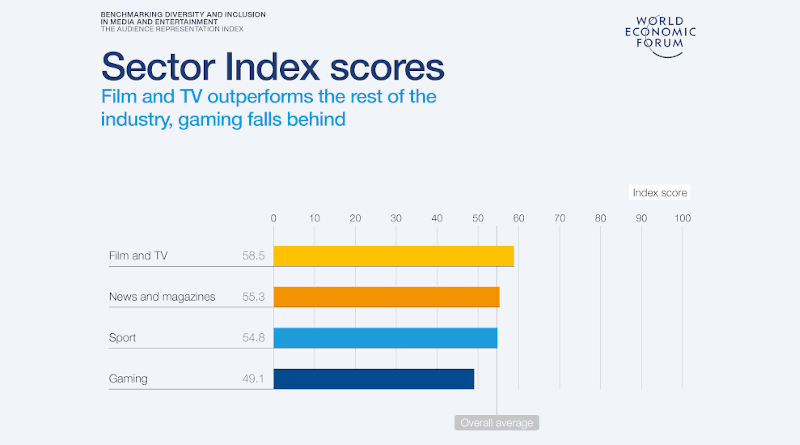WEF Launches Audience Representation Index To Provide Diversity, Equity And Inclusion Scores In Media, Entertainment And Sport
The World Economic Forum’s Power of Media Initiative has developed a first-of-its-kind Audience Representation Index, providing a benchmark for how well consumers see themselves represented in film and TV, gaming, news and magazines, and sport – and whether those industries are contributing to community and society.
The index is based on research that polled more than 7,000 respondents from audiences in the US, the UK and France across gender, race and ethnicity, heritage, ability, sexual orientation and age as well as the intersections between these. All industry sectors were assessed on four dimensions that constitute effective diversity, equity and inclusion (DE&I) practices: equitable representation (who is being represented), authentic representation (is the representation nuanced and non-stereotypical), community building and societal impact.
The index, produced in collaboration with Accenture, Ipsos and Nielsen, shows the relative performance across sectors as well as sector-specific results, and the conclusion is clear: the media and entertainment industry has work to do to advance DE&I efforts to improve audience representation. Among the key insights, the report notes that:
- There is room for growth: The media and entertainment industry has a clear opportunity to improve diverse representation in its content. The index reveals that with an overall average score of 54.6, no sector yet demonstrates a leading level of maturity (scoring 75–100 on a 100-point scale)
- DE&I has business implications: The research shows that a 10-point improvement in the Audience Representation Index delivers a 1.3x boost in how likely consumers are to trust a brand
- Efforts already made are having an effect: Film and TV’s targeted efforts to increase representation leave audiences feeling seen, as did gaming’s appeal to people with disabilities
- Older and LGBTQ+ groups do not see themselves: LGBTQ+ and older viewers feel least represented across all four sectors, which presents a real opportunity for increased brand loyalty. One out of every two LGTBQ+ consumers said they would stop using a product or service they deemed to be non-inclusive
- The gender gap is a business opportunity: Gaming and sport both exhibit significant gender representation gaps. In sport, men ranked the sector 6% better at promoting inclusive communities than women did
- Actions speak louder: As important as in-content representation is, audiences emphasized the importance of brands driving societal impact through corporate social responsibility activities, ranking this as the most important aspect of representation across all sectors
The index places film and TV ahead of other sectors, while gaming scores least favourably overall. The specific challenges and opportunities in each sector are highlighted in the report and direct leaders towards the most important issues for their audiences.
“The Power of Media initiative is committed to building prosperous, inclusive and equitable economies and societies that create opportunities for all and help to advance the voices of under-represented groups in media content. It is imperative for organizations to be able to measure their DE&I footprint to truly understand the gaps that need to be addressed,” said Cathy Li, Head of Media, Entertainment and Sport at the Forum.
The World Economic Forum’s Power of Media Taskforce on Diversity, Equity and Inclusion brings together leaders from across the industry, including those in creative leadership roles, independent non-profits focused on DE&I, corporate executives, creators and DE&I professionals, to answer the call for transparency and drive change as a community. The following initiatives are the first steps in a journey to support change:
- Cross-sector industry report: Our previous report, Reflecting Society: The State of Diverse Representation in Media and Entertainment, as the first of a planned annual series, established the baseline and laid out the best practices
- Metrics and industry index: The 2022 Audience Representation Index serves as an initial coordinated industry contribution to align on a common set of metrics to measure progress over time, identify trends and hold all players accountable
- Industry-wide commitment: The taskforce intends to define a set of high-level principles and commitments from organizations to work together on change, based on shared experience and effort
“We believe that the future workforce is an equal one. To match this ambition, organizations must create products and services that meet the full diversity of their audience, fostering an environment where all feel they belong and are heard,” said Kathleen O’Reilly, global lead of Accenture Strategy. “The social impact stemming from a culture that embraces inclusion and diversity – as a core strategy both internally for their people and externally for their customers – will be among the top differentiators for whether companies thrive or get left behind in the inclusive future we must build together.”
Ben Page, Chief Executive Officer at Ipsos added: “Ipsos’ research shows that older people – the wealthiest age group on the planet – and LGBTQ people are most likely to feel underrepresented across the media. This matters because we can show that where people see “people like them” represented on screen or in print, they are markedly more likely to trust the content provider”
In the months ahead, the Power of Media Taskforce will continue to collaborate with the industry to strengthen the index framework and explore opportunities to improve diversity and representation in each media sector. The aim will be to refresh the results annually to measure progress and advance transparency and accountability, helping organizations truly reflect the diversity in society.

